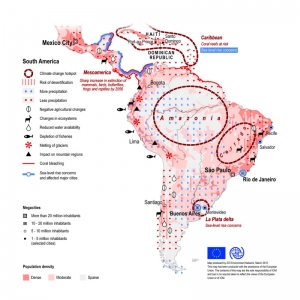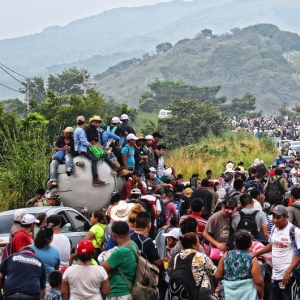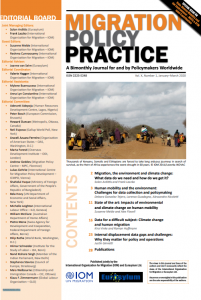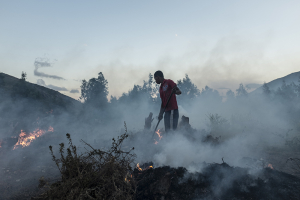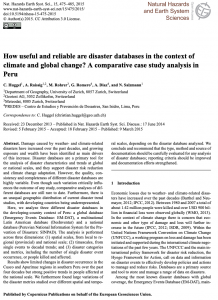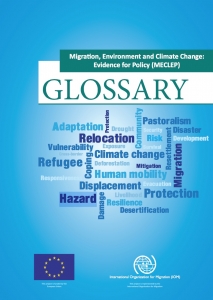Environmental change, including climate change and environmental degradation, seems to have become our “new normal.” 2019, in particular, has been marked by an increase of international attention to commit and act on reducing climate change as shown by the UN Climate Action Summit as well as a rise of reports warning of environmental and socio-economic consequences if unfettered climate change is not addressed. These reports followed a landmark report from the Intergovernmental Panel on Climate Change (IPCC) which actually set a timeline for reducing global carbon dioxide emissions to avoid the most dire consequences of global warming—12 years.
2019 was also marked by extraordinary international reaction to this “new normal.” Across more than 100 countries, millions took to the streets and joined the “Fridays for Future” demonstrations, a global school strike against climate change inaction that was inspired by 16-year-old Greta Thunberg. In late November, even nature itself appeared to indict climate change inaction. In an ironic twist, waters flooded the chambers of the Venice Council in Italy minutes after it rejected measures that were designed to combat climate change.
If a warming planet, sea-level rise and extreme weather events like floods and cyclones are our shared reality and future, what does it all mean for migration? That’s the subject of a newly released paper by IOM’s Global Migration Data Analysis Centre.
While the effects of climate change have been known since the 1980s and there are numerous examples of migration occurring in a changing climate across the continents, the scope of this paper is broader than most as it consolidates findings from almost 150 studies, including large-scale multi-country comparative studies and smaller scale studies across academic journal articles, government reports, and other publications. The 4 main questions the paper aims to answer are:
- Will environment changes like hurricane, wildfires, and floods (known as sudden-onset events) cause people to move?
- Will sea-level rise and drought (known as slow-onset events) cause people to move?
- What are the links between environmental migration and conflict?
- When environmental changes happen, what may drive some people to move and others to stay?
The answers—though not new—reiterate and underscore what experts have known and have been saying for years. Here’s a preview:
Gender and socio-economics influence vulnerability and migration
Gender roles can influence the vulnerability conditions to certain hazards and disasters, and in the worst-case scenario, can also impede your mobility. According to the report, one study (2004) of the disaster impacts in Bangladesh found that women accounted for 90 per cent of flood-related deaths (Flavell, Melde and Milan, 2020: p 18). Part of the reason this occurred was because warning information was communicated by men to men and rarely shared to the rest of the family, and the existence of social norms prohibited women from leaving their homes without a male relative (ibid.). Though not studied widely, men can also be vulnerable in disaster situations because of social norms. One study (2007) on Hurricane Mitch that found evidence that masculine gender norms affected men’s vulnerability because they drove men to higher risk-taking behaviour such as attempts to rescue survivors (Flavell, Milan and Melde, 2020: p 47).
Low levels of socio-economic development can also influence vulnerability and migration responses. According to one report by the Internal Displacement Monitoring Centre, displacement risk is concentrated in countries that have lower levels of social and economic development. In the case of Hurricane Katrina, studies like the Laska and Morrow one (2006), showed differences in displacement patterns between economically affluent communities and those that were economically disadvantaged. Poorer, more vulnerable sections of the population were far more likely to be displaced in conditions of vulnerability or be unable to flee. In addition, poorer households were more likely to lack the economic cushion that is necessary in a long post-disaster response and recovery period, and that could facilitate relocation (Flavell, Melde and Milan, 2020: p 17).
Having a disaster policy and plan makes a difference
The presence of government policies and plans, such as early warning systems and evacuation plans, can mitigate the impacts of disasters. In places where policy measures are in place, it is less likely that a high number of people are displaced to disparate locations where they may not have access to help (Flavell, Melde and Milan, 2020: p 18). According to an IDMC report, Cuba offers an ideal case study. From an early age, “all Cubans are taught what to do when hurricanes approach […]. Disaster preparedness, prevention and response are part of the national curriculum, and people of all ages take part in drills, simulation exercises and other training” (IDMC, 2018: p 44).
Migration responses to sea-level rise take different forms
We often imagine inundation when we hear about sea-level rise, but there are in fact a range of impacts from sea-level rise before the land becomes truly inundated and uninhabitable. Some examples include salinization of groundwater and agricultural land in coastal areas as well as coastal erosion. In the case of salinization of groundwater and agricultural land, people can use temporary or seasonal migration as an adaptation strategy as their livelihoods gradually erode (Flavell, Melde and Milan, 2020: p 22). If crop yields decrease over time below subsistence levels or the availability of fresh groundwater is in danger, people may consider permanently migrating. A case in point is developing countries that lack the capacity to implement alternative water-supply solutions (desalination plants, or diversion of rivers for instance (Flavell, Melde and Milan, 2020: p 23).
Given the slow-onset nature of sea-level rise and based on the severity of the impact from sea-level rise, people’s migration responses can take different forms—temporary or seasonal labour migration, permanent out-migration, internal or international planned relocation, and other forms. In turn, these different migration responses influence people’s vulnerability (Flavell, Melde and Milan, 2020: p 22).
Linkages between conflict and environmental migration are complex and nuanced
While there is a tendency in international climate diplomacy to link migration to conflict in receiving areas, there is not a clear cause-effect chain (Flavell, Melde and Milan, 2020: p 30). The potential for conflict in communities that receive environmental migrants depends on many factors such as the type of and timeframe of environmental migration, the presence of other conflict drivers, and governance, to name a few.
Studies on the impacts of environmental degradation on refugee—host relationships show that there is more potential for conflict if large numbers of people move over relatively short timeframes and to destinations already straining to cope with existing challenges (Flavell, Melde and Milan, 2020: p 31). In addition, studies show that disaster displacement is less likely to result in conflict in receiving areas than conflict displacement. The reason? Unlike displacement resulting from conflict which can trigger large refugee flows to neighboring countries and which can be perceived as a threat due to refugees’ different ethnic origin, language, and culture, displacement resulting from disasters triggers internal migration flows of people who are in general more similar to receiving communities and therefore less likely to be perceived as a threat (ibid.).
Compared to situations that generate refugee flows to neighboring countries, situations of disaster displacement have less potential for conflict, as people displaced by disasters are usually displaced within their own country, and therefore less likely to be perceived as a threat (Flavell, Melde and Milan, 2020: p 30).
Perception of risks influences decisions to stay and not move
In spite of environmental change that can impact their lives, people may decide to stay or are not able to move for a variety of reasons. For these “immobile populations”, as they are called in research, perceptions of risks and opportunities play an important role in their decision to stay (Flavell, Melde and Milan, 2020: p 35). People’s perception of risks run the gamut. Some people decide to stay because they simply are not aware of an environmental hazard. Some may be aware of the hazard, but do not expect a disaster. Others may expect a disaster, but do not anticipate any loss or if they expect a loss, they don’t think it will be a serious loss. In other cases, people may know the risks but stay and adapt to environmental changes because of ancestral ties to land and culture (ibid.).
With population growth and urbanization on the rise, more people now live in areas that are exposed to sudden- and slow-onset environmental hazards. As a result, the prevalence of immobile populations in vulnerable areas is a growing concern for policymakers (Flavell, Melde and Milan, 2020: p 35.).
Lack of capital may “trap” people, even if moving is the preferred choice
When facing environmental hazards, people need capital to move. Without capital such as financial (wealth, access to credit, money for transportation and new housing), social (networks in potential destinations), and human (skills, knowledge) capital, people may be unable to leave (Flavell, Melde and Milan., 2020: p. 36). Trapped populations may be among the most vulnerable to the impact of environmental change as being “trapped” could exacerbate other vulnerabilities. If one cannot move because they lack the capital to do so, environment changes could erode their livelihood (falling crop yields, for instance), resulting in further depletion of the capital needed to move (ibid.:p. 37). According to the United Kingdom’s Foresight project, millions of people in low-income countries could be “trapped” in environmentally exposed areas and unable to move, lacking the resources or opportunities for migration over the coming decades.
While it may be convenient to simplify the linkages between environmental change and migration, the links are in fact complex, multi-dimensional, and not always direct. Other factors, such socio-economic development, gender, governance and political context, cannot be ignored and must be further studied. A better understanding of this complexity shows us that environmental change and migration touches upon many policy areas and that a more comprehensive, coherent and integrated policy and practice approach is needed moving forward.
1 This blog is based on a paper titled “Migration, environment and climate change: Impacts” (Texte 43/2020), which is part of a three-part series on migration, the environment and climate change produced by IOM’s GMDAC and Adelphi for the German Environment Agency (UBA), financed by the German Federal Ministry for the Environment, Nature Conservation and Nuclear Safety (BMU). The impacts paper was completed in November 2019 and is the second of three papers produced under the project “Environmental degradation, climate change and migration: Synopsis of the review and forecasts on migration and flight induced by environment degradation and climate change” for the German Environment Agency (UBA) and financed by the German Federal Ministry for the Environment, Nature Conservation and Nuclear Safety (BMU). The paper’s aim is to better understand the interplay of different causal factors, including environmental change, on migration in specific contexts (local, national or regional), and was prepared by Alex Flavell, Susanne Melde and Andrea Milan.
Disclaimer: The opinions expressed in this blog are those of the authors and do not necessarily reflect the views of the International Organization for Migration (IOM) or the United Nations. Any designations employed and the presentation of material throughout the blog do not imply the expression of any opinion whatsoever on the part of IOM concerning the legal status of any country, territory, city or area, or of its authorities, or concerning its frontiers and boundaries.
Flavell, A., A. Milan and S. Melde
| 2020 | Migration, environment and climate change: Literature review. First report in the “Migration, environment and climate change” series. German Environment Agency. Berlin, March. |
Flavell, A., S. Melde and A. Milan
| 2020 |
Migration, environment and climate change: Impacts. Second report in the “Migration, environment and climate change” series. German Environment Agency. Berlin, March. |
Wright, E., D. Tänzler and L Rüttinger
| 2020 |
Migration, environment and climate change: Responding via climate change adaptation policy. Third report in the “Migration, environment and climate change” series. German Environment Agency. Berlin, March. |
International Organization for Migration and Eurasylum
| 2020 |
Migration Policy Practice: Data, Human Mobility and the Environment. Vol. X, Number 1, January - March 2020. |
Intergovernmental Panel on Climate Change
| 2018 |
Internal Displacement Monitoring Centre (IDMC)
| 2018 |
Global Report on Internal Displacement (GRID). IDMC, Geneva. |
Foresight
| 2011 |
Migration and Global Environmental Change. Future Challenges and Opportunities. Final Project Report. The Government Office for Science, London. |
Laska S. and B Murrow
| 2006 |
Social Vulnerabilities and Hurricane Katrina: An Unnatural Disaster in New Orleans. Marine Technology Society Journal, 40(4):16-26. |



